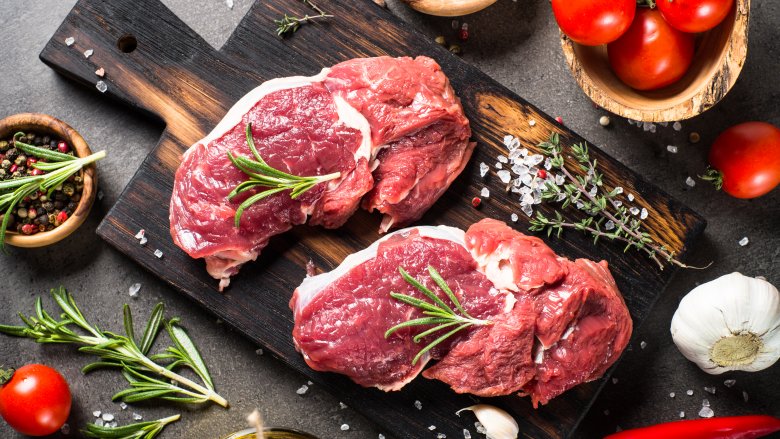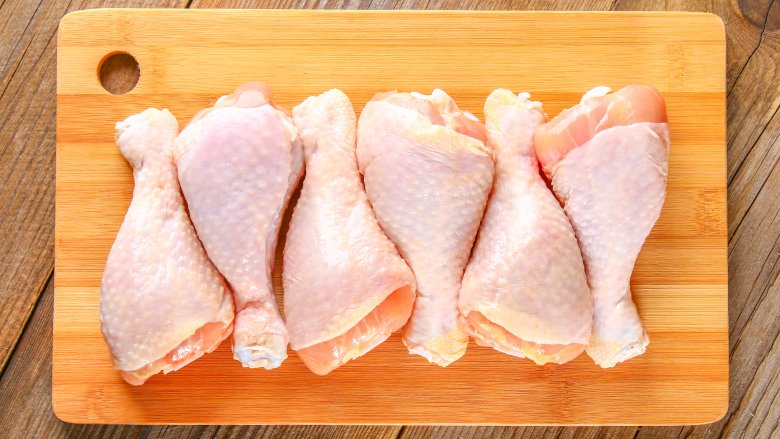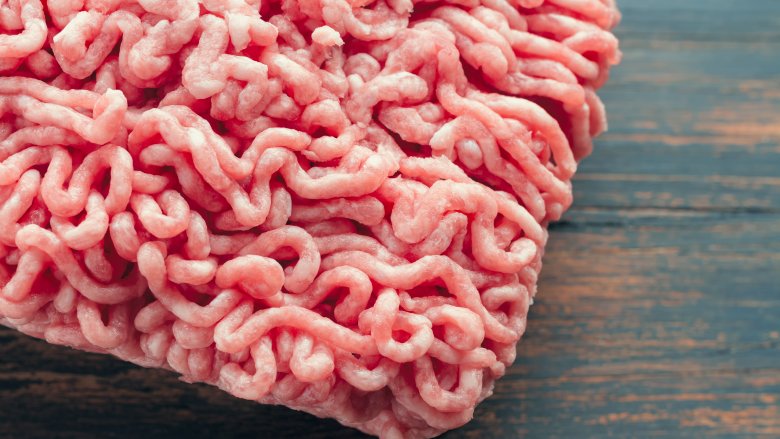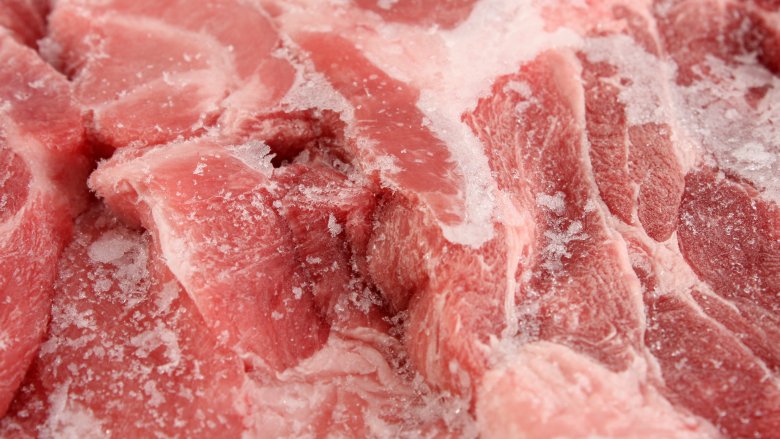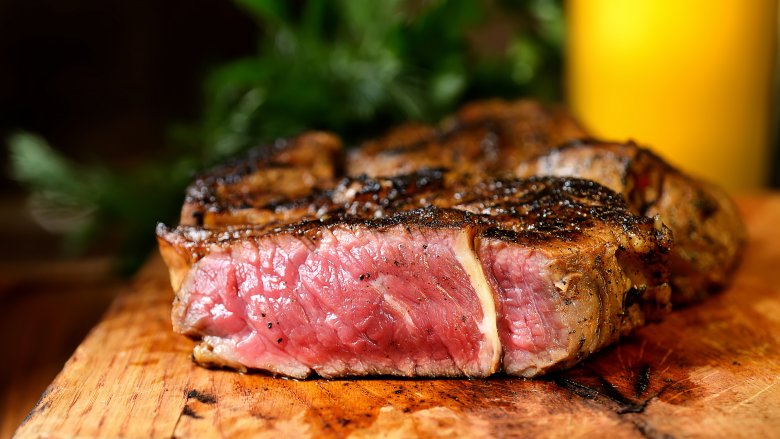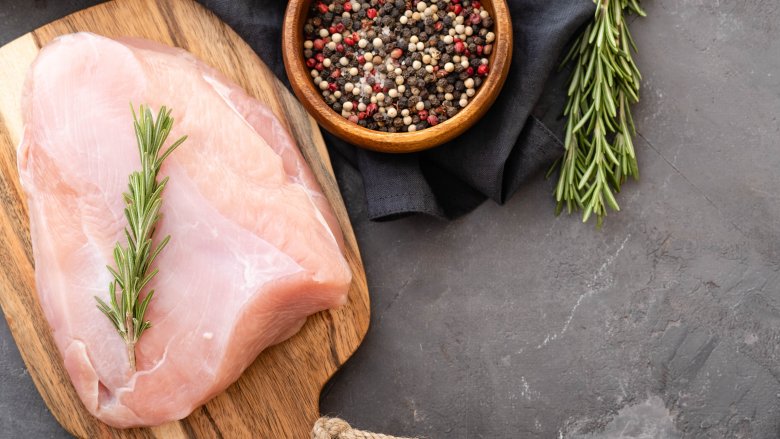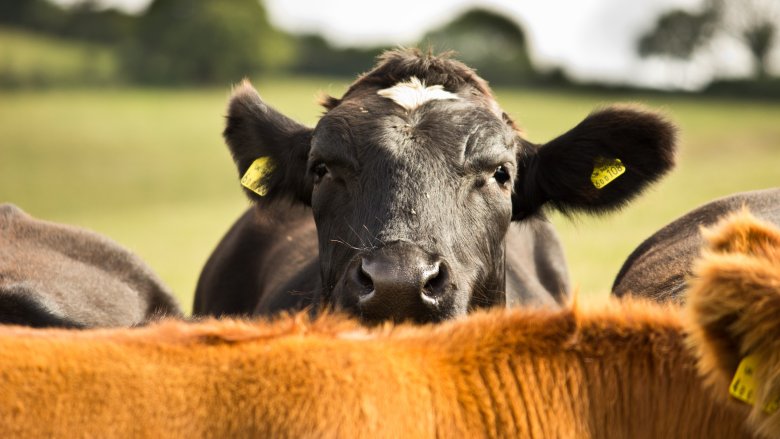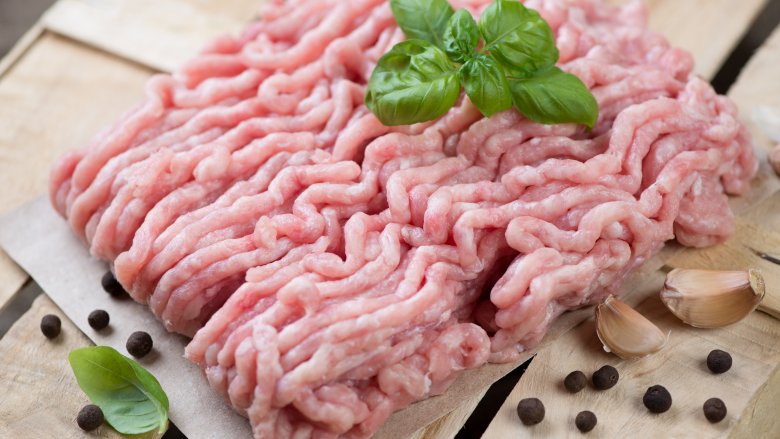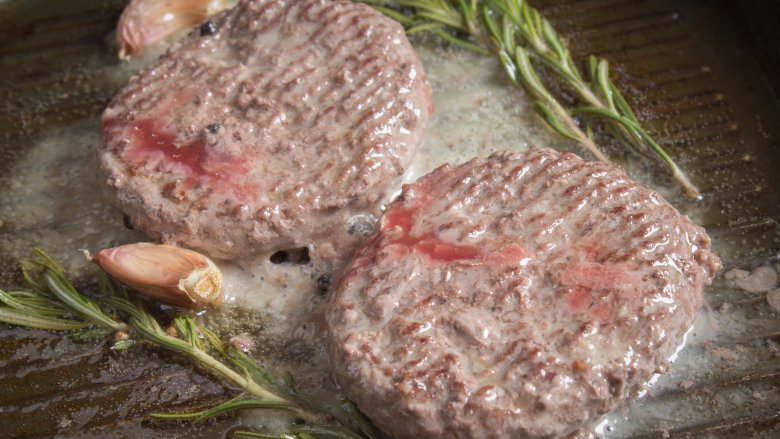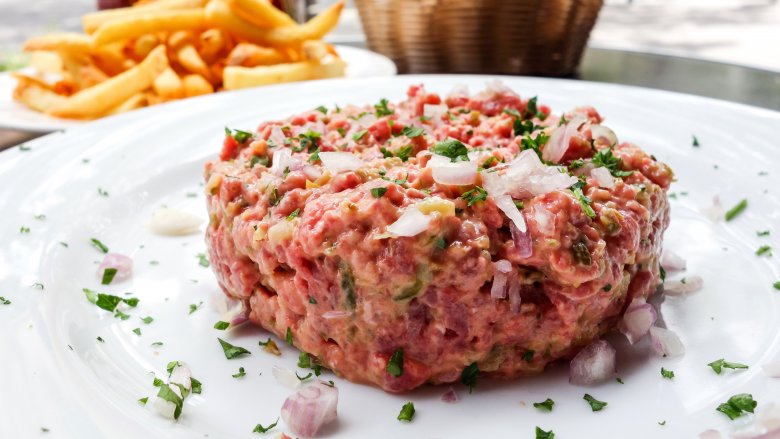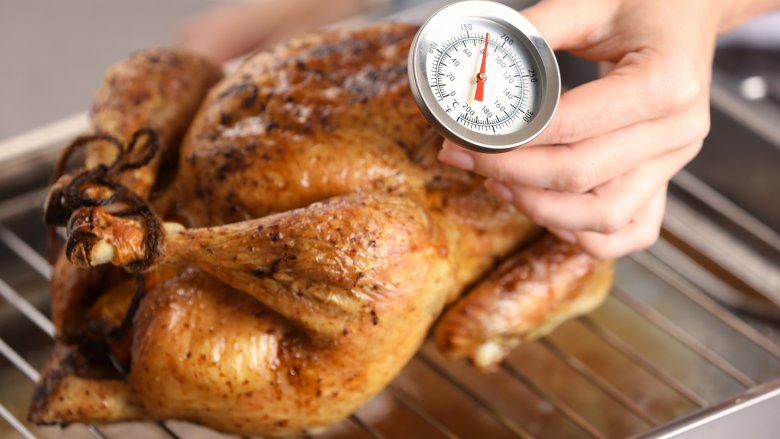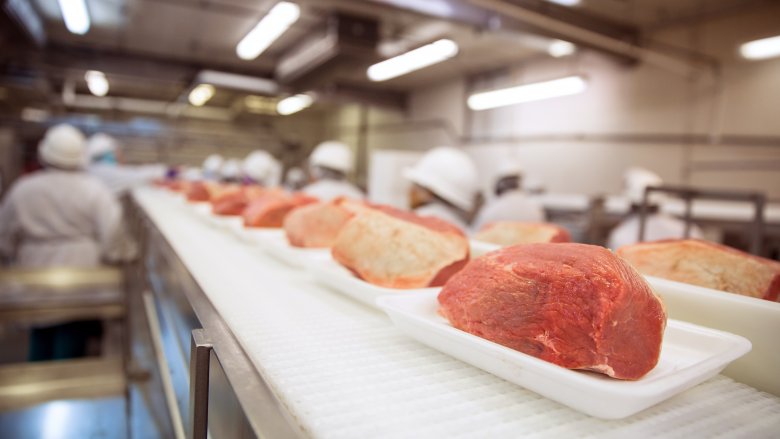Why It's Never Safe To Eat Raw Meats
We all have those people in our families. There's the ones that want their meat well-done, and the ones that not only condemn those people, but proudly declare they want their steak still mooing. It's all down to personal taste, sure, but there's something else that's even more important: safety.
According to Healthline, food poisoning is extremely common, and it's caused by foods that contain bacteria, parasites, or viruses. Many foods have those organisms in them, but they're killed when they're cooked. When food — like meat — is eaten raw or rare, that's when some serious problems can start.
Food poisoning isn't fun, and it's characterized by things like abdominal pain, diarrhea, vomiting, headaches, fever, chills, fatigue, nausea, and an overall feeling of being so sore and so sick that you're debating about whether or not you ever want to eat anything again. Anyone who has suffered through a bout of it can attest to just how terrible it is, and here's the thing — raw and undercooked meats are still a popular (and sometimes pricey) dish at many restaurants. What's going on here? Let's talk.
What kind of bacteria are we talking about?
Bacteria and viruses are still one of the biggest reasons you don't want to serve your family raw steaks or burgers, and there's a lot of them that can be present in all types of meat. According to the Academy of Nutrition and Dietetics, the Centers for Disease Control and Prevention have identified eight pathogens that are responsible for the 48 million people who get sick (and the 128,000 people who are hospitalized) every year with food poisoning — and many of them are found in meat.
The American Meat Science Association has done a run-down of all the different kinds of foodborne illness and beef, they say, is a common carrier of E. coli, which can cause food poisoning — and bloody diarrhea — when it's ingested, usually by eating raw meat or food that has come in contact with raw juices. It's also possible for beef to carry Staphylococcus or Listeria, and the list for chicken is even longer.
Salmonella. Staphylococcus. Listeria. E.coli. Campylobacter. They're all found in chicken, and how about pork? They're all there, too, with the exception of Campylobacter. But don't worry, that's replaced on the list with Yersinia, which specifically comes from the large intestine of pigs. Quite the list, isn't it?
Here's why ground meats must be completely cooked
Let's look at all ground meats, whether it's beef, chicken, turkey, pork, or lamb. The National Research Council says that absolutely all of them must be completely cooked in order to guarantee they're safe to eat, and here's why.
When meat is first processed, most of the bacteria lives on the surface. When it's ground, though, that surface area gets mixed all throughout the meat. That means the entire thing could harbor bacteria that's going to potentially make you — and your dinner guests — sick, but cooking it all the way through gets rid of the risk.
And the only way to make sure you're killing all the bacteria that's potentially been mixed throughout, say, your hamburger, is to cook it to temperature.
And it's nearly impossible to stress just how important that is. According to the USDA, some strains are so virulent that it only takes a couple of these microscopic organisms to cause serious illness. You might be thinking that since this bacteria is often introduced at the processing stage, it would be safer to grind your own at home, right? Not so, they say. In a plant overseen by the USDA, the first cuts of meat — called primal cuts — slated for being turned into ground meat are tested for E.coli. Other cuts — like the ones you would use to grind your own — aren't tested. It's just one more layer of protection for you.
No, it doesn't matter if it was frozen
It's one of those bits of kitchen wisdom that seems like it makes sense, and it's the idea that the freezing process should kill off a lot of the bacteria and germs in your food. But it's completely wrong.
According to research specialist Trevor Suslow from the University of California, Davis (via NPR), the freezing process actually helps preserve all those little microorganisms that will make you sick, and the only thing it's actually killing are the ones responsible for making food spoil. The baddies will come right back to life once they're thawed.
Doesn't seem fair, does it?
And it was something that had been proven in a very real-world situation. In 2013, there was a massive product recall of snacks, quesadillas, and cheesesteaks. All were frozen, and all were linked to a 15-state outbreak of E.coli.
Food science professor Martin Wiedmann of Cornell University said it wasn't the least bit surprising, and it wasn't just E.coli that could survive the freezing process. He added that freezing was actually the easiest way they had to store the pathogens and microbes kept in their lab for research.
Even rare steak can be questionable
It's a widespread belief that ordering a steak that's done rare won't come with a side of food poisoning — it did touch the grill, after all — but it's not that clear-cut anymore.
In 2013, The Center for Science in the Public Interest (via Prevention) collected and analyzed 12 years of data from the CDC. They were looking at foodborne illness outbreaks, and they found something disturbing when it comes to that steak.
The use of antibiotics in the livestock industry has become a huge problem for a number of reasons. One of the consequences of antibiotic use in the beef industry is that the resulting beef is much, much tougher, and some slaughterhouses have turned to what's called "mechanical tenderization." That's the use of metal blades or needles, driven into the meat to make it more tender.
But that's also carrying bacteria deep into the cut of meat. Where it was a previous belief that bacteria only existed on the outside of a steak and it was fine if you just seared it, that's not necessarily the case anymore. You might be fine if you're sourcing antibiotic-free beef from someone you trust, but do you trust that restaurant?
Food poisoning is a bigger deal than it used to be
Food poisoning is bad — it's killed people, after all. But here in the 21st century, the risk is even greater than it used to be.
Back in 2012, Consumer Reports tested 198 samples of pork. They found Yersinia — a bacteria that children are particularly vulnerable to — in a whopping 69 percent of samples, and they also found low levels of ractopamine, a drug used to promote growth in pigs. (It's legal in the US, but illegal in the EU, China, and Taiwan.) But the biggest problem was that many of the strains of Yersinia were resistant to the antibiotics traditionally administered to treat them, since they were routinely fed to the animals to prevent growth.
And other studies suggest the problem is just getting worse. In 2018, Food Safety News reported that the Food Standards Agency had found chicken and pork samples containing bacteria (including salmonella and campylobacter) that showed signs of antimicrobial resistance (AMR). The FSA added, though, that the chances of actually getting sick from eating meat contaminated with the bacteria was slim... as long as they were handled properly and thoroughly cooked.
How does this bacteria get in our food, anyway?
With all the safeguards, rules, and regulations put in place around our food supply, all this bacteria in our meat seems like a huge oversight. So how does it all end up there?
New York Times Magazine writer Michael Pollan followed a cow destined to meet her maker at a slaughterhouse, and he told PBS that germs and bacteria are simply a part of the industry.
"When the animals arrive at the meatpacking plant from their homes on the feedlot, they're carrying quite a bit of manure. ... their bodies are caked in it. ... So you need to make sure that you remove their hides in such a way that you get all of the manure, and none of it ends up on the meat."
He adds that 99.9 percent of the time, the methods put in place make sure that contamination doesn't happen... but also says "... it's not a perfect system."
And it gets weird. E.coli is particularly well-suited to living in the digestive tract of an animal raised on corn — as many cattle in feedlots are. Switch corn to grass or hay, at least for the last few days of their lives, and the bacteria wouldn't be able to survive in their system. Researchers from Cornell University have proposed this as a way of making meat safer, but since it's a more expensive way to make cows that are, in the end smaller, it's unlikely to take off on a large scale.
Tons and tons of turkey recalls
So, how common is all this bacteria?
Let's take ground turkey as an example. Since 2011, millions and millions of pounds of ground turkey alone have been recalled due to contamination. One of the biggest recalls was issued by the Cargill Meat Solutions Corporation (via the CDC), who recalled a shocking 36 million pounds of ground turkey on August 3, 2011. The turkey had been found to be contaminated with a drug-resistant strain of salmonella, and a month later, they issued another recall for another 185,000 pounds of the same products. At least 136 people were infected, and remember — those are just reported cases.
In December 2018, Jennie-O recalled more than 300,000 pounds of ground turkey after more than 200 people reported getting sick during an outbreak that started in November of that year. It was also associated with 133 hospitalizations and one death.
Then, in March 2019, almost 80,000 pounds of turkey was recalled by Butterball for — once again — salmonella contamination (via USDA). Those are just a few example of recalls from just one very specific type of meat — and the moral of the story is that if you think it's unlikely to happen to you, you might want to reconsider.
The only way to make it safe
SF Gate's Healthy Eating puts it this way: While opting to eat raw or rare meat isn't going to guarantee you'll get sick, it definitely increases the odds. The only way to be pretty sure you're not going to get sick is to cook meat to an internal temperature that's going to kill the bacteria inside, and that varies by meat.
Food Safety has an entire chart dedicated to proper temperatures, but here's a summary: some meats — like fresh beef, lamb, veal, pork, and ham should be cooked to 145 degrees Fahrenheit.
Ground meat and meat mixtures should be brought to 160 degrees Fahrenheit.
Poultry — including chicken, turkey, duck, and goose — should be brought to 165, and here's an important footnote to that. Since these birds are often cooked with stuffing, it's important to make sure the temperature of the stuffing hits that mark, too.
With the processes that meat undergoes, making sure it's reached those temperatures in the center of the thickest part of the meat is really the only way to make sure you're not serving up a plateful of bacteria along with your burgers.
But what about dishes traditionally served raw?
Even the Michelin Guide lists a whole bunch of dishes that are traditionally served raw. Take sashimi. You might think of fish when it comes to this one, but it can also be chicken, venison, or even horse. Then there's tartare (which can also be raw beef or seafood), crudo (raw fish), carpaccio (paper-thin raw beef), and ceviche (cured raw fish).
They're served all the time and people eat them all the time, all over the world... so what makes them safe?
Technically, they're not. According to the Academy of Nutrition and Dietetics, there's no way to guarantee the safety of raw meat, no matter who it's prepared by or where it comes from. There's always a chance that it's going to contain some kind of bacteria that's going to make you sick, and that's why even these long-time raw delicacies aren't recommended for people who are particularly susceptible to food poisoning and to the effects of becoming very, very ill.
And no, you can't tell by looking at it
So, you know you need to cook meat completely through in order to kill any bacteria that's hanging around inside it, and that's a good thing. But there's something of a catch: according to the USDA, it doesn't matter how long you've been cooking for, you can't tell when meat has reached that magical, bacteria-killing temperature without using a thermometer.
Let's take hamburgers. They're done when the meat turns that delicious-looking brown color, right? Wrong. According to their research, one in every four hamburgers will turn that distinctive brown color well before the patty has reached the internal temperature you're looking for.
There's a ton of different options out there when it comes to food thermometers, and according to the Academy of Nutrition and Dietetics, there's also a ton of different ways to temp your meat — but only one is right for the type of meat you're cooking. For example, for roasts, burgers, chops, and steaks, insert the thermometer in the middle of the thickest part, but away from fat, bone, or gristle. The temperature of whole poultry should be taken in the thickest part of the thigh, while for whole turkey and game birds, you're looking at the innermost part of the thigh and wing, along with the thickest area. Otherwise, you might end up with rare meat after all.
The meat industry is trying
Is there good news on the horizon for those who like rare meats? Eh.
According to The New York Times, beef slaughterhouses and meat processing facilities — like Tyson Fresh Meats — spend more than $350 million a year just on controlling diseases and bacteria. But still, recalls keep happening in spite of all the precautions put in place, so whether or not we're ever going to have meat we don't have to worry about... that's up for debate.
Michael T. Osterholm of the CDC had this to say about the problem: "If you gave me a million, zillion dollars and said give me a plant that doesn't have E.coli, I couldn't do it. It's not about the will. It's about the ability."
At the heart of the problem is that the meat industry — and all its rules and regulations — is dealing with a biological contaminant. And you probably wouldn't want them to even try all of the control methods that have been proposed. The government has even suggested using radiation, saying that's a completely safe way to kill disease-causing bacteria. But would you want them to? It's an uphill battle, and one thing experts say time and time again is that there's simply no magic bullet for getting rid of all the pathogens.
Who is at the greatest risk?
So, what should you do? Simply put, cook your meat to the proper temperature — especially if you or someone in your family falls into the high risk groups laid out by the FDA.
There's an estimated 48 million cases of food poisoning each year, and they say there are some people who are more likely to suffer severe consequences than others. Pregnant women are at the top of the list, and the FDA says it's not just about her, it's about an unborn baby who's also getting exposed to the bacteria. Some bacteria — especially listeria, says Medical News Today — is linked to the threat of miscarriage and stillbirth.
Young children are also at a high risk of serious complications from eating raw meat, because their immune systems are still developing. Older adults and senior citizens can be vulnerable for two main reasons: their immune systems might not be as quick to fight off an infection, and they may have other conditions that already weaken their systems.
And finally, those with chronically compromised immune systems are also at high risk, and those include people who have had transplants, or those diagnosed with things like HIV/AIDS, diabetes, and cancer. They're specifically warned not to eat raw or undercooked meat of any kind, and it's better to be safe than sorry, isn't it?
